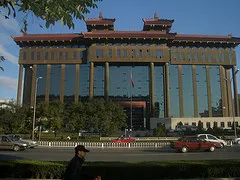| An estimation of Chinese government debt In spite of so many noises, the Chinese government’s debt burden is quite low compared with most other countries. According to our calculation, the current outstanding national government debt is about 42.9% of the 2010 GDP, which is much lower than 81.6% in US and 212.4% in Japan. The main reason for this is that China has lower government deficit. As for 2010, the Chinese central government budget deficit is 1.7% of GDP, which is much lower than that of 8.9% in US.
However, a key feature of the Chinese government debt is that the local government debt is much higher than the central government debt. Based on our calculation, the central government debt is 16.0% and the local government debt is 26.9% of the 2010 GDP. It’s quite unusual compared with other major countries where the levels of central debt are much higher than local debt. Central government debt
To measure government debt, we need to know the boundary of government. Most controversies now fall on four types of institutions: Ministry of Railway, policy banks, Asset Management Companies and the China Investment Corporation. Bonds issued by the Ministry of Railway
The Ministry of Railway had an outstanding RMB373bn in enterprise bonds by the end of July 2011. Proceeds of these bonds were used for investment and daily operations of China’s massive railway system, which is largely profitable. In this regard, we believe it is better to just treat these MoR bonds as enterprise bonds issued by a monopoly SOE with stable cash flows. Policy banks
Shall we take the liability of the three policy banks (China Development Bank, China Agricultural Bank, and China Imports-Exports Bank) as government debt? Our answer is that most of them are not. The main reasons are: (1) Bonds of similar institutions in other countries such as Fannie and Freddie in the US are not counted as government debt; and (2) Returns on those policy banks’ assets are not bad. Actually, the NPL ratio of CDB, by far the largest policy bank, is smaller than 1% for many years. Asset Management Companies
In 1999, China set up four AMCs to take over NPLs from its big-four banks. At that time, the Ministry of Finance injected RMB40bn and the PBoC lentRMB570bn to these AMCs. These AMCs themselves issued a total of RMB820bn (expired in 2009 and rolled over for another 10 years to 2019). The money was then used to swap RMB1.4tn in NPLs from the big-four banks. The question now is how much actual debt should the government assume on AMCs? We believe the answer should be RMB820bn. Regarding the RMB570bn lent by the PBoC, whether we like or not, it was de facto monetized, as it is already unnecessary for the PBoC to withdraw liquidity by that amount if it demands the central government to repay that RMB570bn. The case of CIC
The asset side matters when we study the burden of government debt. One extreme case here is the RMB1.55tn in special bonds issued to set up China Investment Corporation. Since this RMB1.55tn bonds are fully matched by quite liquid FX assets on the asset side with market value significantly above RMB1.55tn as a result of rising stock prices of the big-three banks held by the CIC, it should not be taken as traditional government debt at all. So, we suggest simply excluding this RMB1.55tn from government debt. A summary of central government debt: 16.0% of GDP
Including the RMB400bn issued by the central government on behalf of local governments, the headline government debt was RMB7.2tn at the end of 2010. As we discussed above, we do not need to add in any amount from the Ministry of Railway and policy banks, but we need to add about RMB820bn from those four AMCs. We then need to subtract RMB1.55tn in the CIC special bonds. The revised amount is RMB6.3tn, which is 16.0% of the 2010 GDP. Local government debt
According to China’s National Audit Office, China’s local government debt amounted to RMB10.7tn (26.9% of 2010 GDP) at end-2010, up from RMB9.0tn at end-2009. Among the RMB10.7tn debt, RMB6.7tn (or 62.6% of total debt) is what the local governments are responsible for repaying; RMB2.3tn (or 21.8%) is guaranteed by local governments; and the remaining RMB1.7tn is borrowed by local government-affiliated enterprises, and local governments may need to provide some relief if these enterprises have difficulty in repaying that debt. The distribution of local government debt is uneven. Debt ratios are high at some local governments: 78 prefecture governments (19.9% of prefecture governments) and 99 county governments (3.4% of county governments) have debt ratios higher than 100% for debt responsible for. Ratio of total public debt to GDP
Based on the calculation above, we have central government debt as 16.0% and local government debt as 26.9% of the 2010 GDP. Put together, we get the ratio of total public debt to GDP of 42.9% of the 2010 GDP, which is pretty low compared with other countries. However, the composition of China’s public debt is fairly unusual that the stock of local debt is higher than central government debt. For most of the countries in the world, the opposite is true. It reflects the feature of regional decentralization of the Chinese fiscal system as we mentioned in one of the past issues. | 








![Cross Domain [Manu + SBR + ABF + ABR + FMCG + HBR + ]](https://cmg-qa.s3.ap-southeast-1.amazonaws.com/s3fs-public/styles/exclusive_featured_article/public/2025-01/earth-3537401_1920_4.jpg.webp?itok=WaRpTJwE)









 Advertise
Advertise


